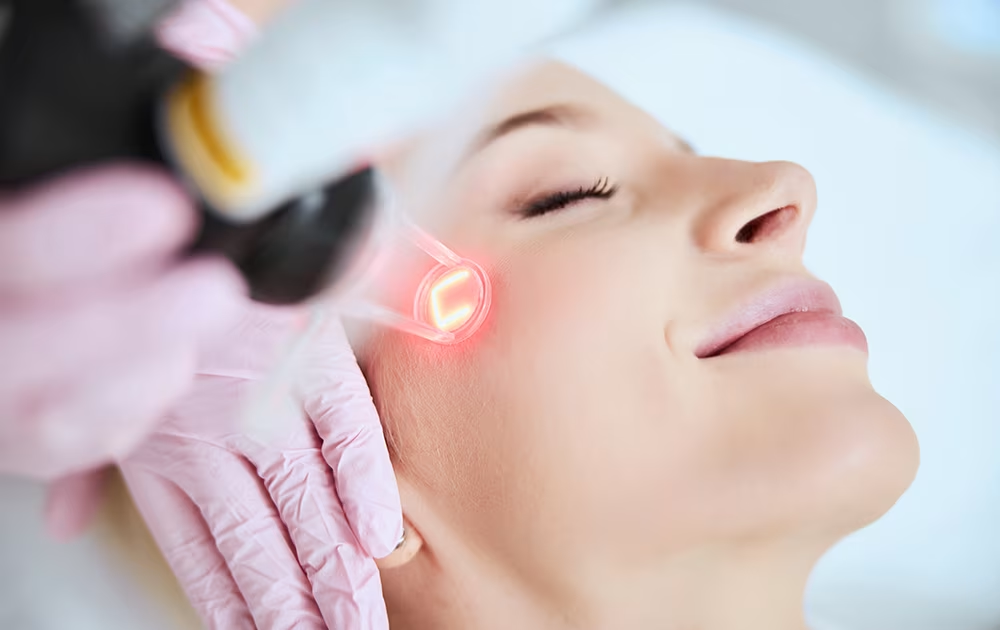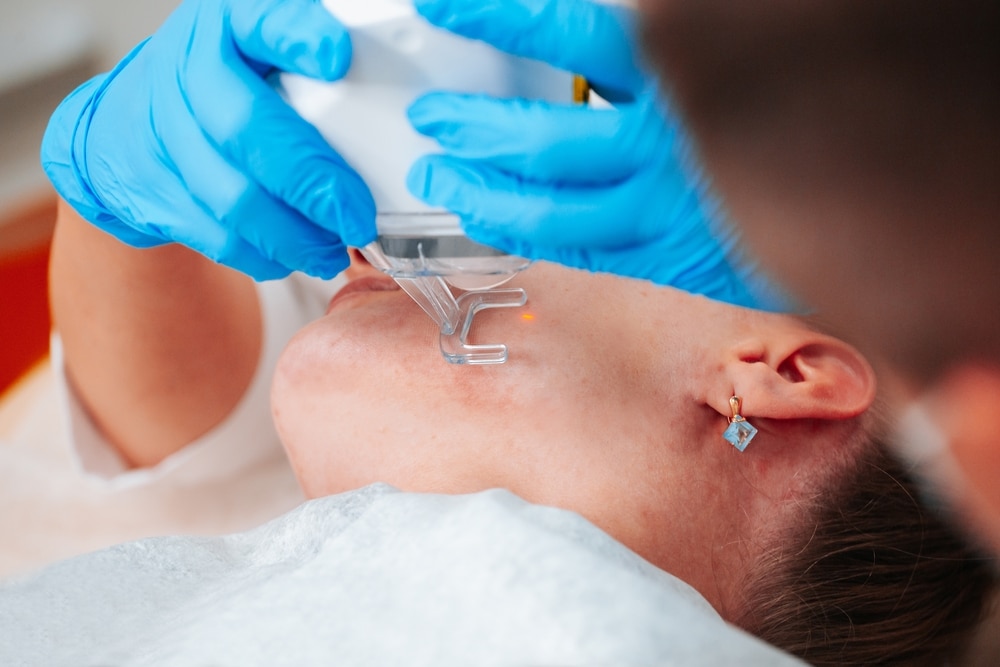
Looking for a way to freshen up your skin and reduce those signs of aging and damage? CO2 laser skin resurfacing could be just what you need. This innovative treatment can help with wrinkles, fine lines, skin texture, tone, and even acne scars.
But before you decide, it’s good to know about the potential risks and side effects, and whether it’s a good fit for you. In this article, we’ll explain everything about CO2 laser skin resurfacing: how it works, the benefits, risks, recovery process, and how long the results last. If you’re interested in this modern cosmetic treatment, read on to learn more.
Benefits and Recovery of CO2 Laser Skin Resurfacing
- CO2 laser skin resurfacing effectively reduces wrinkles, fine lines, acne scars, and tightens loose skin by stimulating collagen production and promoting skin rejuvenation.
- The procedure improves skin texture and tone, resulting in smoother, firmer, and more youthful-looking skin.
- Common side effects include temporary redness, swelling, skin discoloration, and, rarely, infection and scarring.
- Ideal candidates for this treatment are those with sun damage, fine lines, acne scars, and uneven skin tone and texture.
- The recovery process involves initial redness and sensitivity, followed by peeling and gradual improvement in skin appearance over several weeks, with results lasting for years with proper care.
What Is CO2 Laser Skin Resurfacing?
CO2 laser skin resurfacing is a non-surgical way to refresh your skin using focused light beams to improve how your skin looks and feels.
This treatment can help with wrinkles, facial scars, age spots, and uneven skin tone. The CO2 laser works by penetrating your skin’s layers, boosting collagen production, and removing damaged outer layers, so new, healthier skin can come through. It’s often used on the face, neck, and chest and is known for giving great results with little downtime.
By speeding up cell turnover and improving skin elasticity, this treatment can leave you with smoother, younger-looking skin.
What Are the Benefits of CO2 Laser Skin Resurfacing?
CO2 laser skin resurfacing comes with a bunch of benefits. It can reduce wrinkles and fine lines, improve your skin’s texture and tone, treat acne scars, and tighten loose skin.
The laser boosts collagen production, which helps you look younger and gives you long-lasting results. Because the CO2 laser is very precise, it targets specific areas without harming the surrounding skin.
It’s also great for dealing with sun-damaged skin, age spots, and uneven skin tone, giving you a smoother and more radiant complexion. Thanks to its versatility, CO2 laser skin resurfacing is a go-to choice for people looking for overall skin rejuvenation.
Reduces Wrinkles and Fine Lines
CO2 laser skin resurfacing is great at reducing wrinkles and fine lines. It boosts collagen production and tightens your skin.
This advanced treatment uses short pulses of concentrated light on your skin, targeting specific areas to kickstart your body’s natural healing response.
This increased collagen production improves your skin’s texture and firmness.
By reaching the deeper layers of your skin, CO2 laser resurfacing can significantly reduce the appearance of wrinkles and fine lines, giving you a smoother, more youthful look.
Improves Skin Texture and Tone
One of the main benefits of CO2 laser skin resurfacing is that it can greatly improve your skin’s texture and tone, giving you a more youthful and radiant look.
This cutting-edge method promotes the production of collagen and starts your body’s natural healing process by carefully eliminating layers of damaged skin. Your skin gets considerably firmer and healthier as a result, and fine lines and wrinkles are smoothed out.
Your complexion looks better overall and sagging skin is lessened thanks to the increased elasticity.
Treats Acne Scars
Because it encourages skin cell regeneration and lessens the visibility of scar tissue, laser resurfacing is a successful treatment for acne scars.
This procedure increases the skin’s natural production of collagen while also promoting the growth of new, healthy skin cells by applying focused beams of CO2 laser energy to the damaged areas.
This process not only smoothens the skin’s texture but also minimizes the depth and visibility of acne scars, resulting in a more even complexion.
Tightens Loose Skin
CO2 laser skin resurfacing is a great way to tighten loose skin. It boosts collagen production and improves skin elasticity, giving you a more youthful and firm appearance.
This advanced technique works by precisely removing damaged skin layers, which triggers your body’s natural healing process and increases collagen formation. As a result, fine lines and wrinkles are smoothed out, and your skin becomes noticeably tighter and more resilient.
The increased elasticity helps reduce sagging skin and overall improves your complexion. CO2 laser resurfacing offers a thorough solution for anyone looking for significant skin tightening effects.
What Are the Risks and Side Effects of CO2 Laser Skin Resurfacing?
While CO2 laser skin resurfacing offers numerous benefits, it also carries some potential complications, including temporary redness and swelling, skin discoloration, infection, and scarring.
If you’re thinking about getting CO2 laser skin resurfacing, it’s important to know about the potential risks. While redness and swelling are common right after the treatment and usually go away in a few days, there’s a chance of prolonged redness and skin discoloration.
Infection, though rare, is a serious risk and needs quick medical attention. Scarring can also happen, especially if you don’t follow the proper post-treatment care instructions.
Temporary Redness and Swelling
Temporary redness and swelling are common side effects of CO2 laser skin resurfacing and usually go away within a few days.
Right after the procedure, you might notice redness and swelling. This is a natural response to the treatment and a sign that your skin is starting to heal. These effects should fade as your skin rejuvenates.
It’s important for patients to understand that the temporary redness and swelling are manageable and should not cause any undue concern. The skin’s renewal process eventually leads to a revitalized appearance, leaving behind smoother and more radiant skin.
Skin Discoloration
Skin discoloration may occur after CO2 laser skin resurfacing, leading to temporary changes in pigmentation that usually fade over time.
During the healing process following CO2 laser skin resurfacing, skin discoloration can often be observed. This may manifest as redness, brown patches, or uneven skin tone.
Remember that these changes are usually very temporary and will go away over time as the skin heals. The discoloration is typically a normal part of the healing process, therefore patients having this procedure should be reassured as well as aware of this risk.
Infection
Infection is a potential risk following a laser resurfacing procedure, although it is rare when proper post-procedure care and hygiene measures are observed.
It is crucial for patients to follow the post-procedure care instructions provided by their dermatologist or skin care specialist to minimize the risk of infection.
Proper hygiene is essential for proper healing. This includes regular gentle cleansing of the treated area and the application of prescribed topical medications. Patients should also avoid touching the treated skin with unwashed hands to prevent introducing bacteria.
While the risk of infection is low, it’s important for individuals undergoing CO2 laser skin resurfacing to be diligent in their aftercare routine to ensure the best possible outcome.
Scarring
Scarring is a possible side effect of CO2 laser skin resurfacing, although it is uncommon and can be minimized with appropriate post-procedure care and follow-up.
While scarring is a potential risk, it’s important to note that the occurrence of significant scarring after CO2 laser skin resurfacing is rare. Proper aftercare and adherence to the dermatologist’s instructions can greatly reduce the likelihood of developing noticeable scars.
The risk of scarring can be further mitigated by choosing an experienced and skilled professional to perform the procedure, as their precision and expertise can make a significant difference.
Who Is a Suitable Candidate for Laser Skin Resurfacing?
Good candidates for laser resurfacing typically include individuals with sun damage and fine lines, acne scars, and those seeking improvements in skin tone and texture.
These individuals often have concerns about signs of aging, such as wrinkles and age spots, or uneven skin texture due to acne scarring.
They may also have hyperpigmentation, rough skin, or enlarged pores that they wish to address through C02 Laser Resurfacing.
Suitable candidates for this treatment are those who are looking to rejuvenate their skin and achieve a smoother, more radiant complexion.
People with Sun Damage and Fine Lines
Individuals with sun damage and fine lines are ideal candidates for CO2 laser skin resurfacing, as the treatment effectively addresses these specific skin concerns.
CO2 laser skin resurfacing targets damaged areas of the skin by delivering short pulses of high-energy light, stimulating the production of new collagen and elastin.
This process leads to the regeneration of healthier, smoother skin that reduces the appearance of sun damage and fine lines.
The precision of the CO2 laser allows for accurate treatment, minimizing damage to surrounding tissue and ensuring controlled improvement in skin texture and tone.
People with Acne Scars
Individuals with acne scars can benefit from CO2 laser skin resurfacing, as the treatment aids in minimizing the appearance of scar tissue and promoting skin regeneration.
CO2 laser skin resurfacing works by delivering short pulses of high-energy laser light to the skin, targeting and removing the damaged outer layers while stimulating the production of new collagen fibers underneath. This process helps to smooth out the uneven texture of acne scars and improve overall skin tone and elasticity.
Many individuals with acne scars have found significant improvement in the appearance of their skin after undergoing CO2 laser resurfacing treatments. The procedure is particularly effective for addressing atrophic and boxcar acne scars, as it helps to fill in the depressions and indentations caused by these types of scars.
Plus reducing the visibility of acne scars, CO2 laser skin resurfacing can also lead to a more youthful and rejuvenated complexion, making it a popular choice for individuals looking to improve the overall quality of their skin.
People with Uneven Skin Tone and Texture
Individuals seeking improvements in skin tone and texture can benefit from CO2 laser skin resurfacing, as the treatment helps in achieving a more even and smoother skin complexion.
CO2 laser skin resurfacing is a popular solution for addressing skin concerns such as wrinkles, fine lines, and acne scars. The procedure utilizes targeted laser energy to remove damaged outer layers of skin, stimulating collagen production and revealing fresher, rejuvenated skin beneath.
By promoting cellular renewal, this treatment effectively improves overall skin texture and tone, producing a revitalized and more youthful appearance. The customizable nature of CO2 laser resurfacing allows for tailored treatment plans, ensuring personalized results that meet individual skincare goals.

How Is CO2 Laser Skin Resurfacing Procedure Performed?
The CO2 laser skin resurfacing procedure involves the precise application of the laser to the targeted areas, ensuring controlled skin rejuvenation and texture enhancement.
During the procedure, the dermatologist or skincare specialist carefully assesses the patient’s skin condition and determines the specific areas that require treatment.
Once the targeted areas are identified, the focused CO2 laser is skillfully deployed to remove damaged skin layers, stimulate collagen production, and ultimately reveal smoother, more youthful skin.
The precision and control inherent in this process allow for customized treatment tailored to the individual’s unique skin concerns, resulting in more predictable and satisfactory outcomes.
What Is the Recovery Process for CO2 Laser Skin Resurfacing?
The recovery process for CO2 laser skin resurfacing involves initial redness and sensitivity, followed by a gradual improvement in skin appearance and texture over the ensuing weeks.
Immediately after the procedure, the skin may appear slightly red and feel sensitive, resembling a mild sunburn sensation. This is a natural response of the skin to the laser treatment and typically subsides within a few days.
As the healing process progresses, the outer layer of the skin begins to shed, revealing newer, smoother skin underneath. This shedding may cause some peeling or flaking, which is part of the skin renewal process. It’s important to keep the skin moisturized and protected from excessive sun exposure during this period for optimal results.
Gradually, over the course of several weeks, the skin’s texture and tone continue to improve, with reduced fine lines, wrinkles, and hyperpigmentation. Collagen production is also stimulated, contributing to enhanced skin firmness and elasticity.
How Long Do the Results of CO2 Laser Skin Resurfacing Last?
The results of CO2 laser skin resurfacing can last for several years, with proper skincare and maintenance, ensuring sustained improvements in skin appearance and texture.
After undergoing CO2 laser skin resurfacing, it’s crucial to protect your skin from excessive sun exposure. This is because UV radiation can speed up skin aging and compromise the benefits of the procedure. To maintain the results, it’s important to follow a daily skincare routine that includes sunscreen, moisturizers, and gentle cleansers. Dermatologists may also recommend periodic maintenance treatments to preserve the outcomes over time. By diligently following these guidelines, individuals can enjoy the long-term rejuvenation effects of the laser procedure.
For more detailed information about CO2 laser skin resurfacing, schedule a consultation with cosmetic surgeon Dr. Hojjat and ensure great results.



